Government Expenditures in Alberta
Archived Content
Information identified as archived is provided for reference, research or recordkeeping purposes. It is not subject to the Government of Canada Web Standards and has not been altered or updated since it was archived. Please "contact us" to request a format other than those available.
A presentation to Alberta Deputy Ministers
February 12, 2018
Anil Arora
Chief Statistician of Canada
On April 11th, 2018, the chart on GDP per capita in chained 2007 dollars was replaced by GDP per capita, at current prices, 2016, which is the appropriate per capita measure.
- Who we are: Statistics Canada
- Reviewing the economic and demographic context
- Government expense by function - Canadian classification of functions of government
Who we are: Statistics Canada
Connecting quality statistics to Canadians' decision making
- Leader in providing quality indicators and supporting responsible use of data
- Capacity building nationwide and government-wide on the use of statistics

Reviewing the economic and demographic context
Alberta is an economic force in Canada
Even as declining oil prices led to an economic downturn it had the highest provincial GDP per capita in 2016

Description for Chart - Percentage change in expenditure-based GDP, chained 2007 dollars
| Year | Alberta | Canada |
|---|---|---|
| 2007 | 2% | 2% |
| 2008 | 2% | 1% |
| 2009 | -6% | -3% |
| 2010 | 5% | 3% |
| 2011 | 6% | 3% |
| 2012 | 4% | 2% |
| 2013 | 6% | 2% |
| 2014 | 6% | 3% |
| 2015 | -4% | 1% |
| 2016 | -4% | 1% |
| 2017 | 7% | 3% |
| Sources: CANSIM table 384-0038; The Conference Board of Canada, Canadian Outlook Economic Forecast: Autumn 2017, and Provincial Outlook: Autumn 2017. | ||
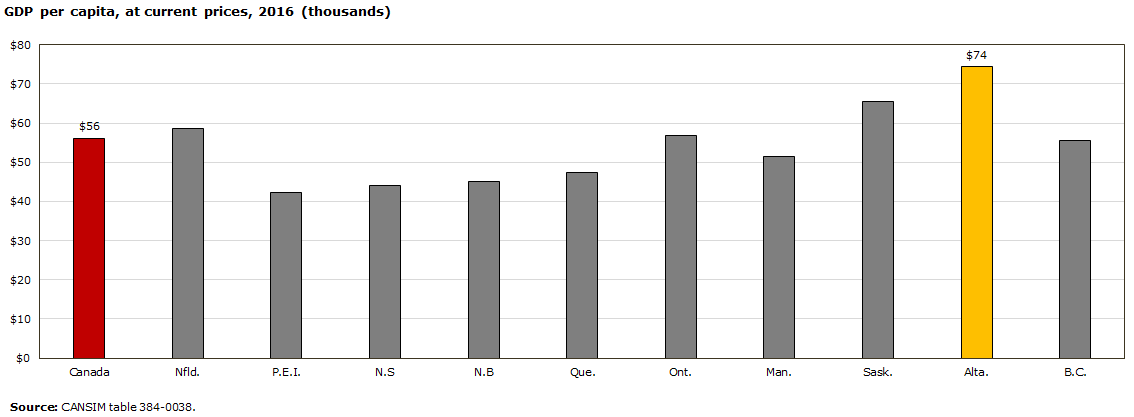
Description for Chart - GDP per capita, at current prices, 2016
| GDP per capita | |
|---|---|
| Canada | $56,129.28 |
| Newfoundland and Labrador | $58,668.12 |
| Prince Edward Island | $42,288.86 |
| Nova Scotia | $43,986.09 |
| New Brunswick | $45,187.12 |
| Quebec | $47,443.44 |
| Ontario | $56,870.12 |
| Manitoba | $51,484.89 |
| Saskatchewan | $65,524.80 |
| Alberta | $74,342.79 |
| British Columbia | $55,427.69 |
| Source: CANSIM table 384-0038. | |
Rich in economic assets
- Oil and gas
- Agriculture
- Tourism
- Science & engineering
A young and growing population
Alberta had the highest population growth amongst provinces between 2011 and 2016
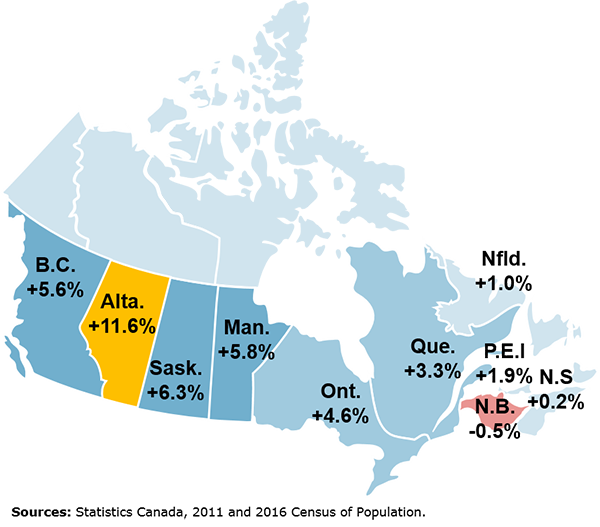
Description for Map - Population growth by province, 2011-2016
| Province | Population growth (%) |
|---|---|
| Newfoundland and Labrador | 1.0% |
| Prince Edward Island | 1.9% |
| Nova Scotia | 0.2% |
| New Brunswick | -0.5% |
| Quebec | 3.3% |
| Ontario | 4.6% |
| Manitoba | 5.8% |
| Saskatchewan | 6.3% |
| Alberta | 11.6% |
| British Columbia | 5.6% |
| Sources: Statistics Canada, 2011 and 2016 Census of Population. | |
Alberta has a young population
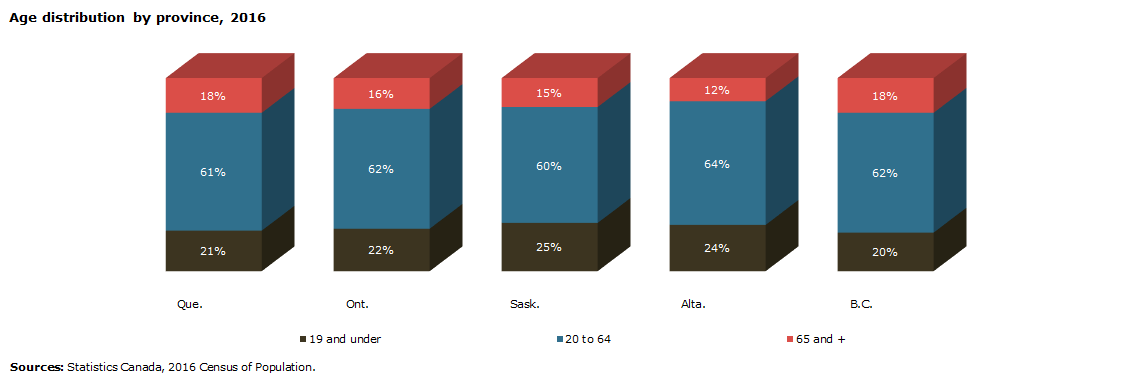
Description for Chart - Age distribution by province, 2016
| Province | 19 and under | 20 to 64 | 65 and + |
|---|---|---|---|
| Quebec | 21% | 61% | 18% |
| Ontario | 22% | 62% | 16% |
| Saskatchewan | 25% | 60% | 15% |
| Alberta | 24% | 64% | 12% |
| British Columbia | 20% | 62% | 18% |
| Source: Statistics Canada, 2016 Census of Population. | |||
A diverse population
Half of the population living in Alberta was born outside the province
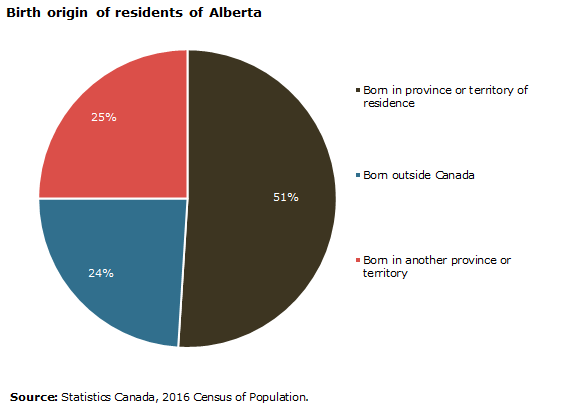
Description for Chart - Birth origin of residents of Alberta
| Percent | |
|---|---|
| Born in province or territory of residence | 51% |
| Born outside Canada | 24% |
| Born in another province or territory | 25% |
| Source: Statistics Canada, 2016 Census of Population. | |

Description for Chart - Birth origin of residents of Canada
| Percent | |
|---|---|
| Born in province or territory of residence | 65% |
| Born outside Canada | 24% |
| Born in another province or territory | 11% |
| Source: Statistics Canada, 2016 Census of Population. | |
Alberta has a sizeable aboriginal population
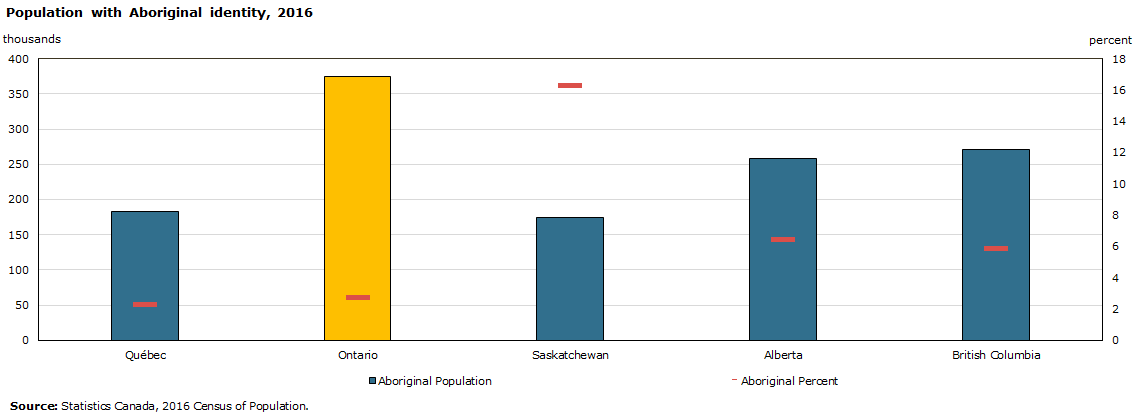
Description for Chart - Population with Aboriginal identity, 2016
| Province | Aboriginal population | Aboriginal percent of population |
|---|---|---|
| Quebec | 182,890 | 2.3 |
| Ontario | 374,395 | 2.8 |
| Saskatchewan | 175,015 | 16.3 |
| Alberta | 258,640 | 6.5 |
| British Columbia | 270,585 | 5.9 |
| Source: Statistics Canada, 2016 Census of Population. | ||
A highly engaged labour force
High participation rate

Description for Chart - Labour force participation rate, both sexes age 15 and over (%)
| Year | Canada | Alberta |
|---|---|---|
| (%) | ||
| 2001 | 65.9 | 72.3 |
| 2002 | 66.9 | 72.9 |
| 2003 | 67.6 | 73.5 |
| 2004 | 67.5 | 73.5 |
| 2005 | 67.1 | 72.7 |
| 2006 | 67.0 | 73.4 |
| 2007 | 67.4 | 74.3 |
| 2008 | 67.6 | 74.7 |
| 2009 | 67.1 | 74.3 |
| 2010 | 66.9 | 73.0 |
| 2011 | 66.7 | 73.6 |
| 2012 | 66.5 | 73.6 |
| 2013 | 66.5 | 73.1 |
| 2014 | 66.0 | 72.7 |
| 2015 | 65.8 | 73.0 |
| 2016 | 65.7 | 72.5 |
| 2017 | 65.8 | 72.4 |
| Source: CANSIM table 282-0002. | ||
High involvement
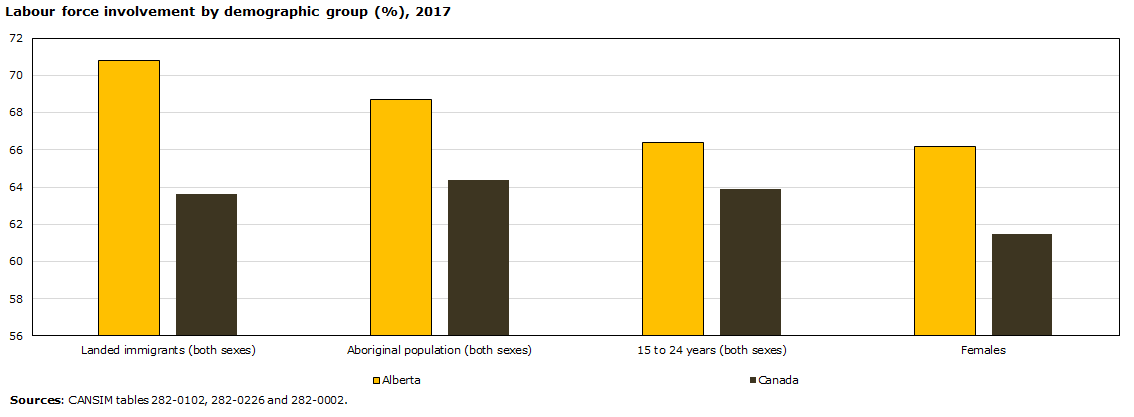
Description for Chart - Labour force involvement by demographic group, 2017
| Canada | Alberta | |
|---|---|---|
| (%) | ||
| Landed immigrants, both sexes | 63.6 | 70.8 |
| Aboriginal population, both sexes | 64.4 | 68.7 |
| 15 to 24 years, both sexes | 63.9 | 66.4 |
| Females | 61.5 | 66.2 |
| Sources: CANSIM tables 282-0102 (immigrants), 282-0226 (Aboriginal), 282-0002 (female and youth). | ||
Recent challenges

Description for Chart - Unemployment rate
| Year | Canada | Alberta |
|---|---|---|
| (%) | ||
| 2001 | 7.2 | 4.7 |
| 2002 | 7.7 | 5.3 |
| 2003 | 7.6 | 5.1 |
| 2004 | 7.2 | 4.7 |
| 2005 | 6.8 | 4.0 |
| 2006 | 6.3 | 3.5 |
| 2007 | 6.0 | 3.5 |
| 2008 | 6.1 | 3.6 |
| 2009 | 8.3 | 6.5 |
| 2010 | 8.1 | 6.6 |
| 2011 | 7.5 | 5.4 |
| 2012 | 7.3 | 4.6 |
| 2013 | 7.1 | 4.6 |
| 2014 | 6.9 | 4.7 |
| 2015 | 6.9 | 6.0 |
| 2016 | 7.0 | 8.1 |
| 2017 | 6.3 | 7.8 |
| Source: CANSIM table 282-0002. | ||
Recent improvements

Description for Chart - Alberta total employment and unemployment rate
| Unemployment rate in % | Employment in thousands | |
|---|---|---|
| January 2014 | 4.7 | 2,239.9 |
| February 2014 | 4.4 | 2,260.4 |
| March 2014 | 5.1 | 2,255.5 |
| April 2014 | 5.0 | 2,258.9 |
| May 2014 | 4.6 | 2,269.2 |
| June 2014 | 4.9 | 2,283.6 |
| July 2014 | 4.5 | 2,282.1 |
| August 2014 | 5.2 | 2,267.2 |
| September 2014 | 4.7 | 2,279.5 |
| October 2014 | 4.5 | 2,289.5 |
| November 2014 | 4.4 | 2,293.1 |
| December 2014 | 4.9 | 2,301.9 |
| January 2015 | 4.6 | 2,311.9 |
| February 2015 | 5.4 | 2,300.1 |
| March 2015 | 5.6 | 2,293.3 |
| April 2015 | 5.7 | 2,309.6 |
| May 2015 | 5.9 | 2,305.5 |
| June 2015 | 5.9 | 2,303.8 |
| July 2015 | 6.1 | 2,304.8 |
| August 2015 | 5.9 | 2,307.9 |
| September 2015 | 6.6 | 2,313.4 |
| October 2015 | 6.7 | 2,296.9 |
| November 2015 | 7.0 | 2,291.3 |
| December 2015 | 7.1 | 2,281.4 |
| January 2016 | 7.5 | 2,273.4 |
| February 2016 | 7.9 | 2,276.6 |
| March 2016 | 7.1 | 2,285.1 |
| April 2016 | 7.5 | 2,267.8 |
| May 2016 | 8.0 | 2,248.3 |
| June 2016 | 8.1 | 2,246.8 |
| July 2016 | 8.7 | 2,252.9 |
| August 2016 | 8.2 | 2,255.2 |
| September 2016 | 8.5 | 2,269.1 |
| October 2016 | 8.5 | 2,275.8 |
| November 2016 | 9.0 | 2,265.9 |
| December 2016 | 8.6 | 2,265.5 |
| January 2017 | 8.7 | 2,268.6 |
| February 2017 | 8.2 | 2,271.8 |
| March 2017 | 8.3 | 2,284.6 |
| April 2017 | 7.9 | 2,286.8 |
| May 2017 | 7.8 | 2,288.9 |
| June 2017 | 7.5 | 2,294.6 |
| July 2017 | 7.8 | 2,285.0 |
| August 2017 | 8.1 | 2,287.6 |
| September 2017 | 7.8 | 2,282.4 |
| October 2017 | 7.6 | 2,292.9 |
| November 2017 | 7.3 | 2,300.0 |
| December 2017 | 7.0 | 2,320.4 |
| Sources: Labour Force Survey (LFS); CANSIM table 282-0087. | ||
More employment in higher paid occupations
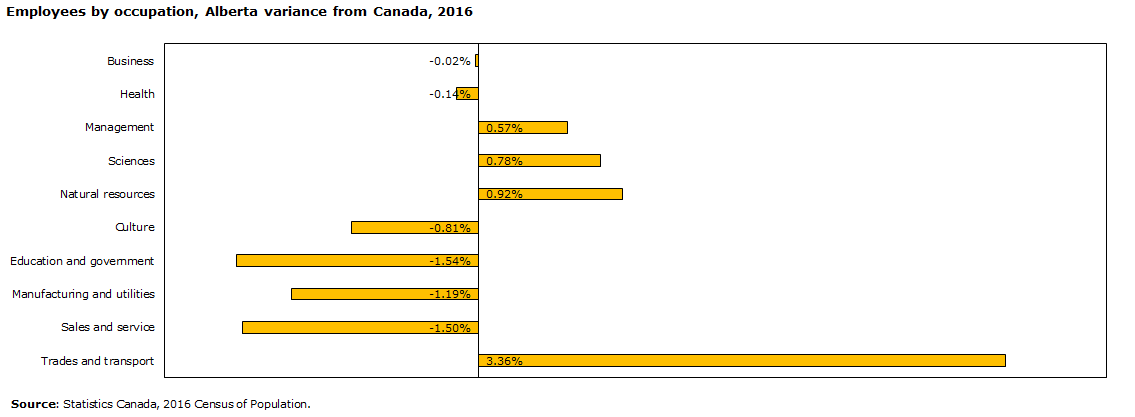
Description for Chart - Employees by occupation, Alberta variance from Canada, 2016
| Occupation | Variance |
|---|---|
| Business | -0.02% |
| Health | -0.14% |
| Management | 0.57% |
| Sciences | 0.78% |
| Natural resources | 0.92% |
| Culture | -0.81% |
| Education and government | -1.54% |
| Manufacturing and utilities | -1.19% |
| Sales and service | -1.50% |
| Trades and transport | 3.36% |
| Source: Statistics Canada, 2016 Census of Population. | |
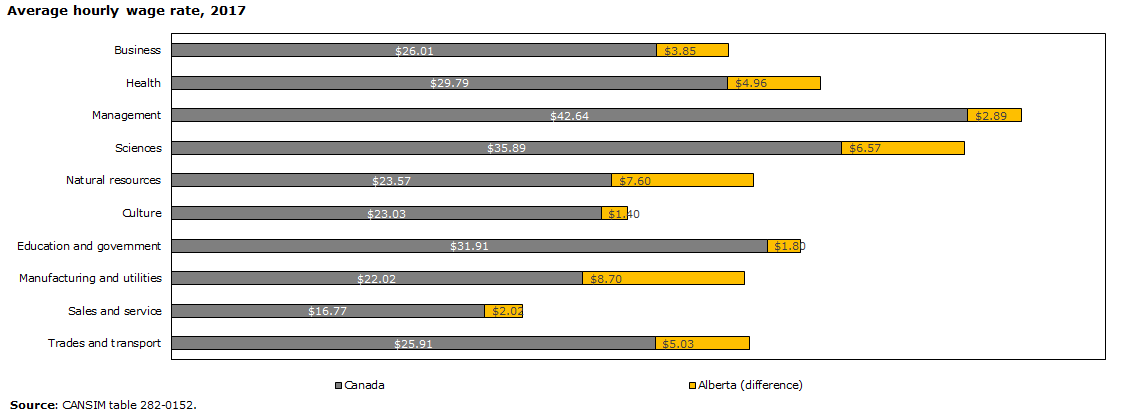
Description for Chart - Average hourly wage rate, 2017
| Alberta | Canada | Alberta (difference) | |
|---|---|---|---|
| Business | 29.25 | 26.01 | 3.85 |
| Health | 34.75 | 29.79 | 4.96 |
| Management | 45.53 | 42.64 | 2.89 |
| Sciences | 42.46 | 35.89 | 6.57 |
| Natural resources | 31.17 | 23.57 | 7.60 |
| Culture | 24.43 | 23.03 | 1.40 |
| Education and government | 33.71 | 31.91 | 1.80 |
| Manufacturing and utilities | 30.72 | 22.02 | 8.70 |
| Sales and service | 18.79 | 16.77 | 2.02 |
| Trades and transport | 30.94 | 25.91 | 5.03 |
| Source: CANSIM table 282-0152. | |||
Alberta's economic assets and skilled workforce support wealth creation
Percentage change in median household income, 2005 to 2015

Description for Map - Percentage change in median household income, 2005 to 2015
| Province | Percentage change in median household income |
|---|---|
| Newfoundland and Labrador | 28.9% |
| Prince Edward Island | 11.1% |
| Nova Scotia | 10.2% |
| New Brunswick | 11.0% |
| Quebec | 8.9% |
| Ontario | 3.8% |
| Manitoba | 20.3% |
| Saskatchewan | 36.5% |
| Alberta | 24.0% |
| British Columbia | 12.2% |
| Sources: Statistics Canada, 2011 and 2016 Census of Population. | |
Lower prevalence of individuals with low income
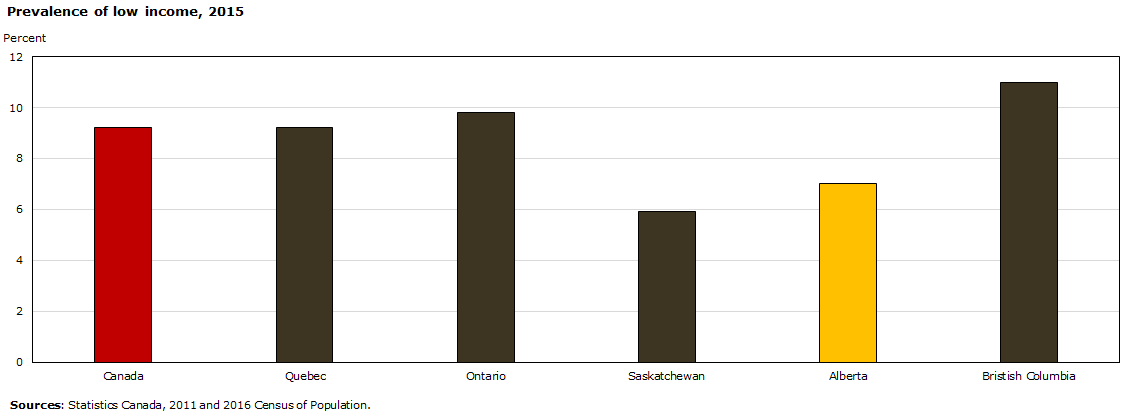
Description for Chart - Prevalence of low income, 2015
| Percent of low income individuals | |
|---|---|
| Canada | 9.2 |
| Quebec | 9.2 |
| Ontario | 9.8 |
| Saskatchewan | 5.9 |
| Alberta | 7.0 |
| British Columbia | 11.0 |
| Sources: Statistics Canada, 2011 and 2016 Census of Population. | |
Albertans spend less of their income on shelter

Description for Chart - Owner spending 30% or more of income on shelter costs, 2016
| Percent | |
|---|---|
| Canada | 16.6 |
| Quebec | 12.9 |
| Ontario | 19.8 |
| Saskatchewan | 12.1 |
| Alberta | 15.1 |
| British Columbia | 20.7 |
| Sources: Statistics Canada, 2011 and 2016 Census of Population. | |
The Alberta government has a revenue profile that reflects its natural resource economy
Receives more royalties, but less sales tax and federal transfers
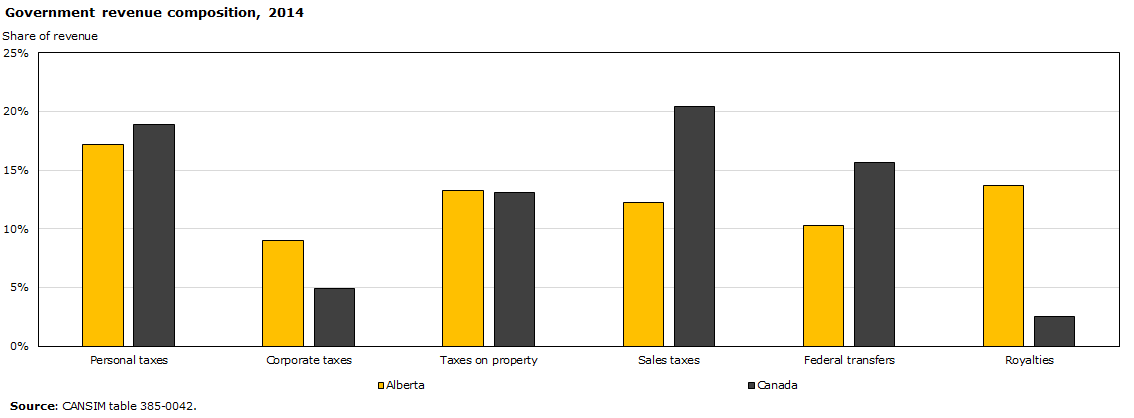
Description for Chart - Government revenue composition, 2014
| Alberta | Canada | |
|---|---|---|
| Personal taxes | 17% | 19% |
| Corporate taxes | 9% | 5% |
| Taxes on property | 13% | 13% |
| Sales taxes | 12% | 20% |
| Federal transfers | 10% | 16% |
| Royalties | 14% | 2% |
| Source: CANSIM table 385-0042. | ||
Royalties and corporate tax revenues decreased due to decline in oil prices

Description for Chart - Alberta government revenue by source, 2014 and 2016
| Alberta | 2014 | 2016 |
|---|---|---|
| dollars (millions) | ||
| Personal taxes | 11,042 | 10,763 |
| Corporate taxes | 5,750 | 3,729 |
| Taxes on property | 8,497 | 9,284 |
| Sales taxes | 7,842 | 9,060 |
| Federal transfers | 6,581 | 7,975 |
| Royalties | 8,760 | 2,923 |
| Source: CANSIM table 385-0042. | ||
Government expense per capita in 2016 are higher than in most provinces

Description for Chart - Government expense per capita ($), 2016
| Province | Expense per capita ($) |
|---|---|
| Quebec | 15,514 |
| Ontario | 13,841 |
| Saskatchewan | 16,906 |
| Alberta | 16,666 |
| British Columbia | 12,980 |
| Source: CANSIM table 385-0042. | |
Alberta spends more on labour, goods and services than other provincial governments
Alberta government spends less on interest and social benefits
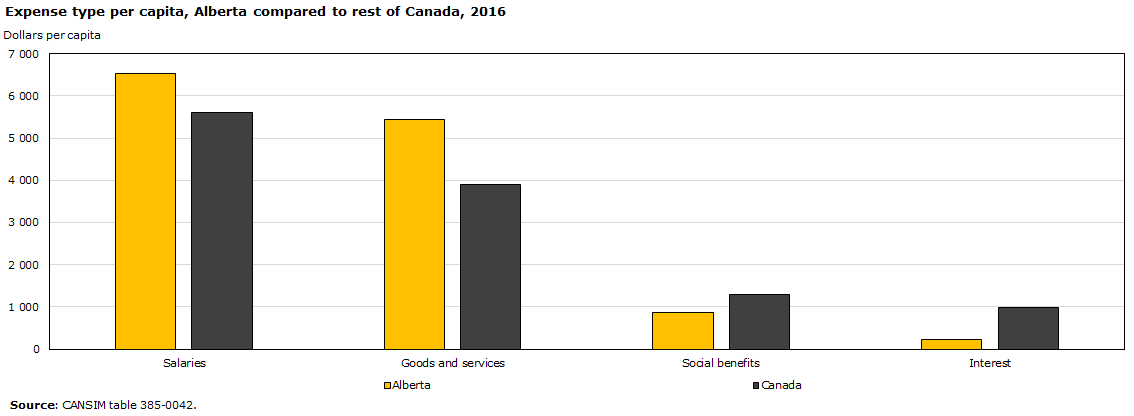
Description for Chart - Expense type per capita, Alberta compared to rest of Canada, 2016
| Alberta | Canada | |
|---|---|---|
| Salaries | 6,535 | 5,612 |
| Goods and services | 5,449 | 3,906 |
| Social benefits | 858 | 1,284 |
| Interest | 226 | 981 |
| Source: CANSIM table 385-0042. | ||
The increase in the price of labour and goods and services for government was strong in Alberta
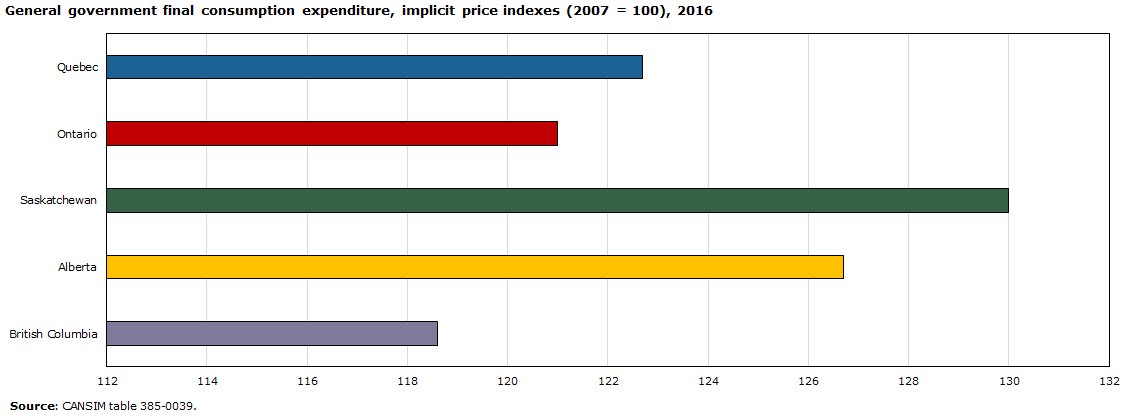
Description for Chart - General government final consumption expenditure, implicit price indexes (2007 = 100), 2016
| Province | 2016 price index |
|---|---|
| Quebec | 122.7 |
| Ontario | 121.0 |
| Saskatchewan | 130.0 |
| Alberta | 126.7 |
| British Columbia | 118.6 |
| Source: CANSIM table 384-0039. | |
Public sector employment continues to grow
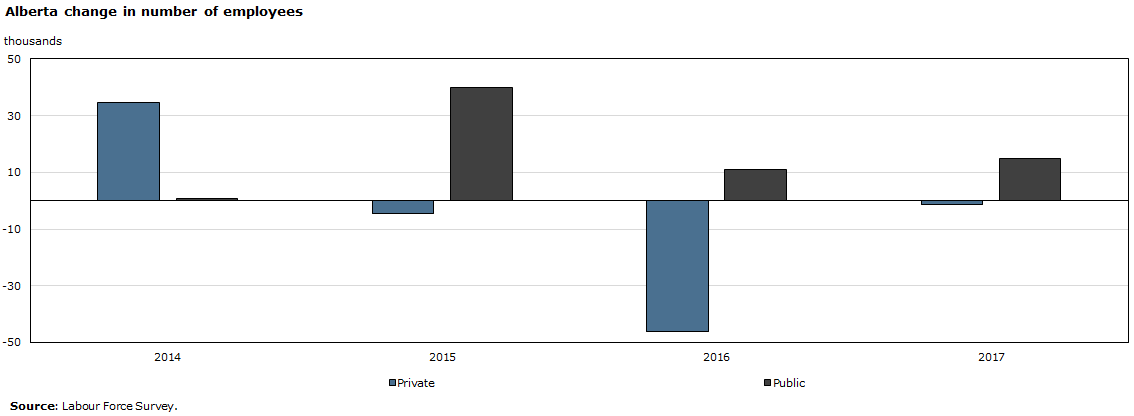
Description for Chart - Alberta change in number of employees
| 2014 | 2015 | 2016 | 2017 | |
|---|---|---|---|---|
| thousands | ||||
| Private | 34.5 | -4.5 | -46.0 | -1.4 |
| Public | 0.8 | 39.9 | 11.1 | 14.8 |
| Source: Labour Force Survey. | ||||
Government expense by function
Canadian Classification of Functions of Government
Over half of Alberta's public expenses are for health and education - a similar proportion to other jurisdictions
| Expense | Percent |
|---|---|
| Economic affairs | 14% |
| Social protection | 10% |
| General public services | 7% |
| Public order and safety | 5% |
| Environmental protection | 4% |
| Recreation, culture, and religion | 3% |
| Housing and community amenities | 2% |
| Source: CANSIM table 385-0041. | |
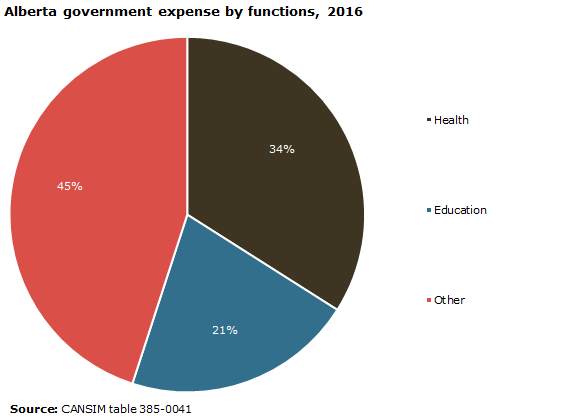
Description for Chart - Alberta government expense by functions, 2016
| Expense | Percent |
|---|---|
| Health | 34% |
| Education | 21% |
| Other | 45% |
| Source: CANSIM table 385-0041. | |
Alberta spends more on health and education per capita than the Canadian average while paying less on social protection and general public services

Description for Chart - Government expense by function per capita, 2016
| Government expense | Alberta | Canada |
|---|---|---|
| $ | ||
| Health | 4,944 | 4,475 |
| Education | 3,047 | 2,455 |
| Economic affairs | 2,112 | 1,275 |
| Social protection | 1,393 | 1,770 |
| General public services | 947 | 1,658 |
| Public order and safety | 762 | 723 |
| Environmental protection | 584 | 301 |
| Housing and community amenities | 352 | 239 |
| Recreation, culture, and religion | 431 | 349 |
| Source: CANSIM table 385-0041. | ||
Wages and payments to physicians are driving health expenses in Alberta
Higher per capita expense on health in Alberta

Description for Chart - Health expense per capita ($), 2016
| Province | Expense per capita |
|---|---|
| Quebec | $4,370 |
| Ontario | $4,180 |
| Saskatchewan | $4,813 |
| Alberta | $4,944 |
| British Columbia | $4,369 |
| Source: CANSIM table 385-0041. | |
Largest difference for wages and salaries

Description for Chart - Health expense per capita by type ($), 2016
| Canada | Alberta | |
|---|---|---|
| $ | ||
| Use of goods and services | 1,043 | 1,096 |
| Compensation of employees | 1,855 | 2,251 |
| Source: CANSIM table 385-0035. | ||
Did you know?
- Payments to physicians in Alberta are the highest in the countryFootnote 1
- 9,026 additional jobs in health in 2016, 32,335 since 2011Footnote 2
- Health building permits value of $2.1 billion since 2010Footnote 3
Health employment and wages continue to increase
Alberta's employment in health grew at a faster pace than Canada

Description for Chart - Employment in healthcare and social assistance (2011 = 100)
| Index | 2011 | 2012 | 2013 | 2014 | 2015 | 2016 |
|---|---|---|---|---|---|---|
| Canada | 100 | 102 | 104 | 106 | 108 | 112 |
| Alberta | 100 | 104 | 107 | 111 | 114 | 120 |
| Source: CANSIM table 281-0024. | ||||||
Wages in health and social assistance are higher in Alberta
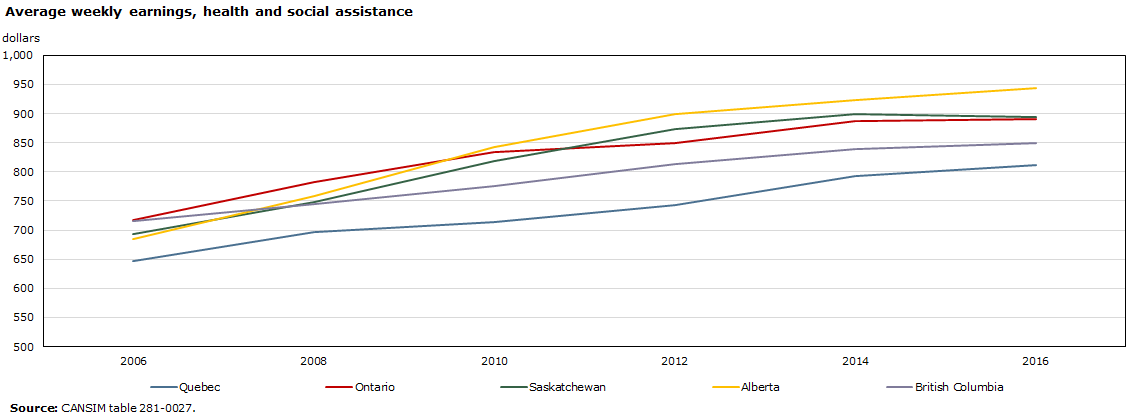
Description for Chart - Average weekly earnings, health and social assistance
| Geography | 2006 | 2008 | 2010 | 2012 | 2014 | 2016 |
|---|---|---|---|---|---|---|
| $ | ||||||
| Quebec | 648 | 697 | 715 | 744 | 793 | 812 |
| Ontario | 717 | 783 | 834 | 849 | 887 | 891 |
| Saskatchewan | 694 | 749 | 818 | 874 | 900 | 893 |
| Alberta | 685 | 758 | 842 | 900 | 924 | 944 |
| British Columbia | 716 | 744 | 776 | 813 | 840 | 850 |
| Source: CANSIM table 281-0027. | ||||||
Despite a younger population, health expenses and demand for services are high in Alberta
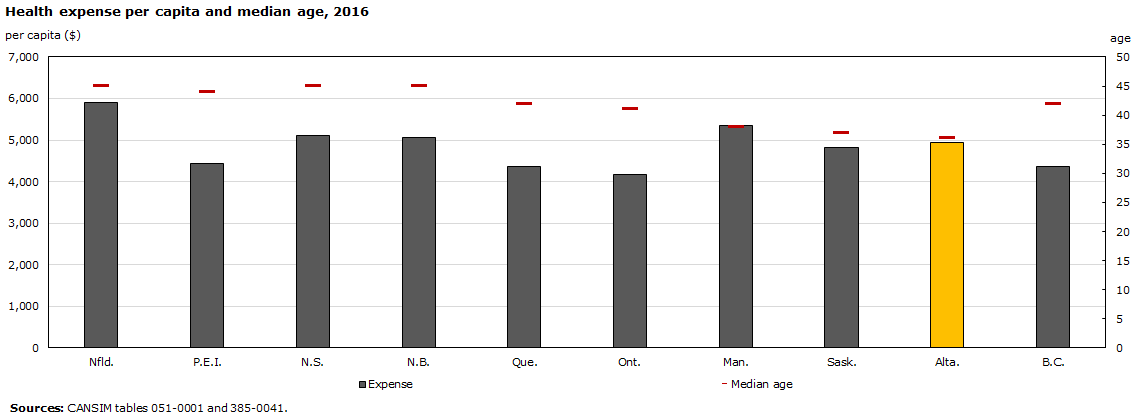
Description for Chart - Health expense per capita and median age, 2016
| Province | Median age | Expense per capita ($) |
|---|---|---|
| Newfoundland | 45 | 5,910 |
| Prince Edward Island | 44 | 4,429 |
| Nova Scotia | 45 | 5,108 |
| New Brunswick | 45 | 5,057 |
| Quebec | 42 | 4,371 |
| Ontario | 41 | 4,180 |
| Manitoba | 38 | 5,340 |
| Saskatchewan | 37 | 4,813 |
| Alberta | 36 | 4,944 |
| British Columbia | 42 | 4,369 |
| Sources: CANSIM tables 051-0001 and 385-0041. | ||
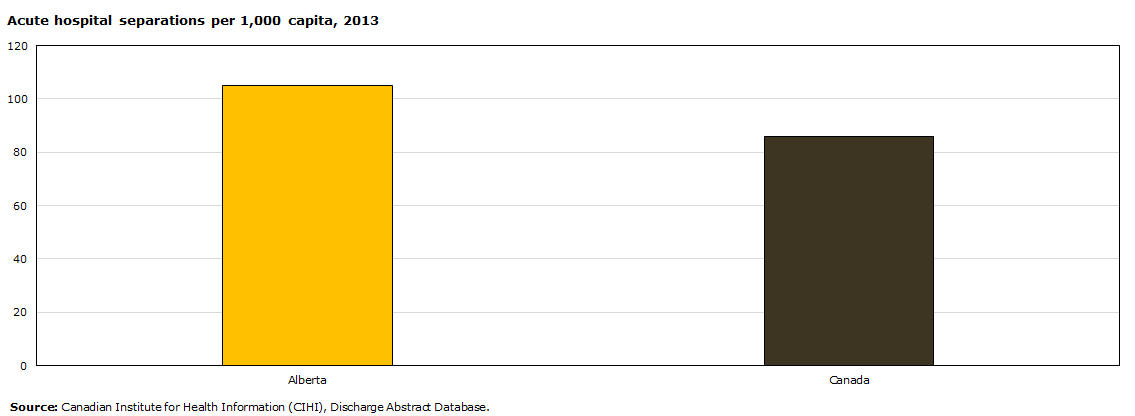
Description for Chart - Acute hospital separations per 1,000 capita, 2013
| Acute hospital separations per 1,000 capita | |
|---|---|
| Alberta | 105 |
| Canada | 86 |
| Source: Canadian Institute for Health Information (CIHI) Discharge Abstract Database. | |
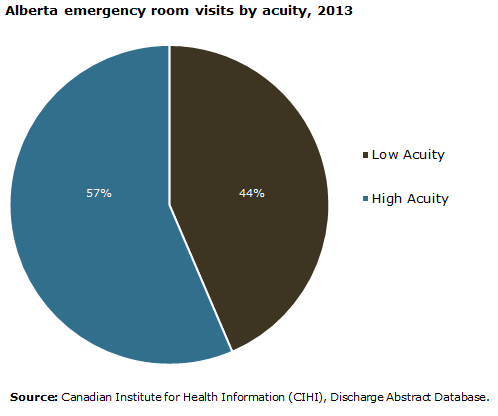
Description for Chart - Alberta emergency room visits by acuity, 2013
Alberta emergency room visits by acuity, 2013:
- Low Acuity: 44%
- High Acuity: 57%
Source: Canadian Institute for Health Information (CIHI) Discharge Abstract Database.
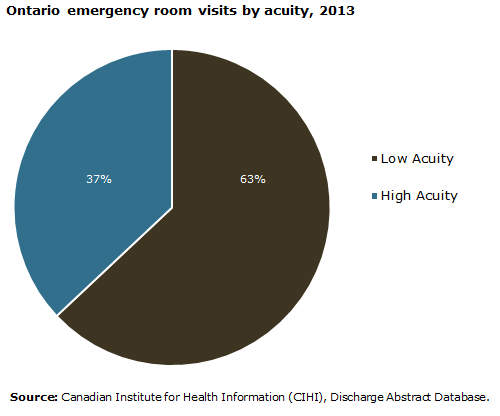
Description for Chart - Ontario emergency room visits by acuity, 2013
Ontario emergency room visits by acuity, 2013:
- Low Acuity: 63%
- High Acuity: 37%
Source: Canadian Institute for Health Information (CIHI) Discharge Abstract Database.
Albertans have higher health risk factors compared to British Columbians who have the best health report card in Canada

Description for Chart - Positive health factors percent of respondents, 2016
| Alberta | British Columbia | |
|---|---|---|
| Has a regular healthcare provider | 82% | 83% |
| Physical activity | 60% | 67% |
| Strong sense of belonging | 70% | 72% |
| Source: CANSIM table 105-0508. | ||

Description for Chart - Negative health factors percent of respondents, 2016
| Alberta | British Columbia | |
|---|---|---|
| Obese | 27% | 22% |
| Daily smoker | 12% | 9% |
| Heavy drinking | 19% | 17% |
| Perceived life stress | 22% | 19% |
| Source: CANSIM table 105-0508. | ||
Alberta Ranks 5th on the Health Report Card
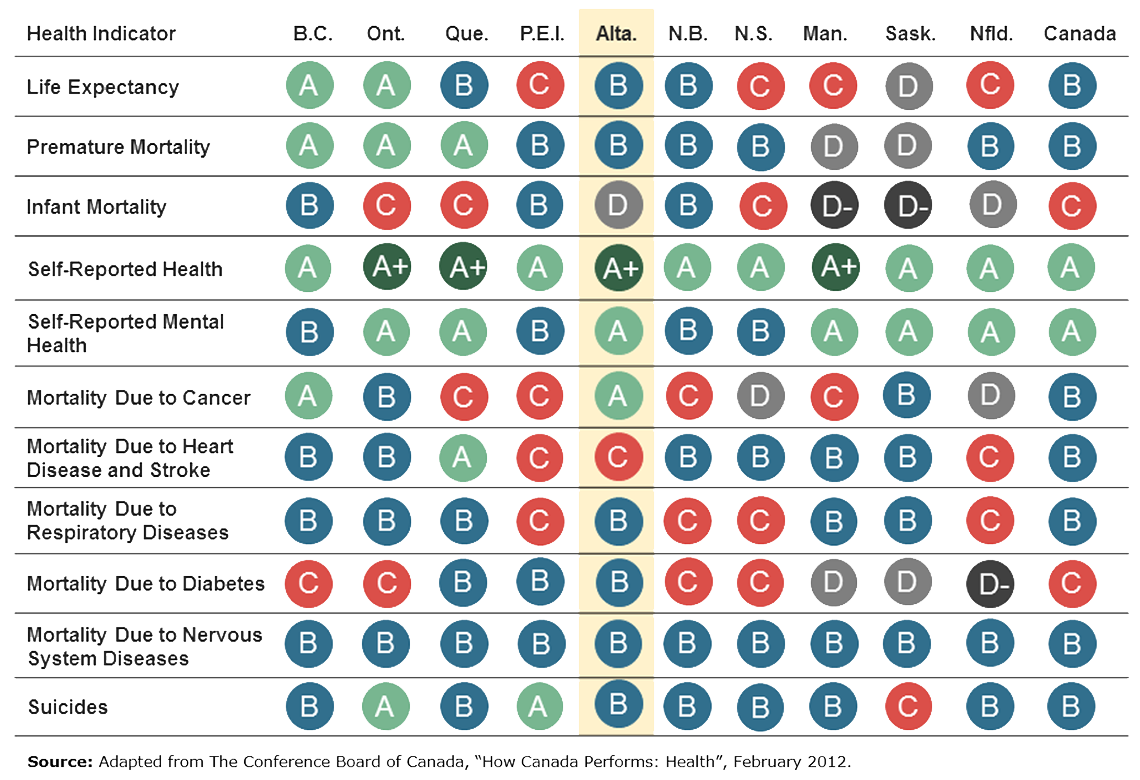
Description for Figure - Alberta Ranks 5th on the Health Report Card
| Health indicator | B.C. | Ont. | Que. | P.E.I. | Alta. | N.B. | N.S. | Man. | Sask. | Nfld. | Canada |
|---|---|---|---|---|---|---|---|---|---|---|---|
| Life expectancy | A | A | B | C | B | B | C | C | D | C | B |
| Premature mortality | A | A | A | B | B | B | B | D | D | B | B |
| Infant mortality | B | C | C | B | D | B | C | D- | D- | D | C |
| Self-reported health | A | A+ | A+ | A | A+ | A | A | A+ | A | A | A |
| Self-reported mental health | B | A | A | B | A | B | B | A | A | A | A |
| Mortality due to cancer | A | B | C | C | A | C | D | C | B | D | B |
| Mortality due to heart disease and stroke | B | B | A | C | C | B | B | B | B | C | B |
| Mortality due to respiratory diseases | B | B | B | C | B | C | C | B | B | C | B |
| Mortality due to diabetes | C | C | B | B | B | C | C | D | D | D- | C |
| Mortality due to nervous system diseases | B | B | B | B | B | B | B | B | B | B | B |
| Suicides | B | A | B | A | B | B | B | B | C | B | B |
| Source: Adapted from The Conference Board of Canada, "How Canada Performs: Health", February 2012. | |||||||||||
The majority of education expense occurs in primary and secondary education
Higher per capita expense on education in Alberta

Description for Chart - Education expense per capita by province ($), 2016
| Province | Education expense per capita ($) |
|---|---|
| Quebec | 2,082 |
| Ontario | 2,485 |
| Saskatchewan | 3,302 |
| Alberta | 3,047 |
| British Columbia | 2,104 |
| Source: CANSIM table 385-0041. | |
Large difference in primary and secondary education

Description for Chart - Education expense per capita by education level, 2016
| Canada | Alberta | |
|---|---|---|
| ($) | ||
| Post-secondary | 862 | 1,019 |
| Primary and secondary | 1,568 | 2,000 |
| Source: CANSIM table 385-0041. | ||
Did you know?
- Primary and secondary teachers in Alberta have the second highest salary amongst the provinces
Alberta: $94,103 Canada: $87,202 - 3,455 additional jobs in education in 2016, 16,626 since 2011
- Education building permits value of $5.4 Billion since 2010
Employment and wages in education are on the rise
Alberta's employment in education grew at a faster pace than Canada

Description for Chart - Employment in education (2011 = 100)
| 2011 | 2012 | 2013 | 2014 | 2015 | 2016 | |
|---|---|---|---|---|---|---|
| Alberta | 100 | 103 | 107 | 107 | 111 | 113 |
| Canada | 100 | 101 | 104 | 105 | 106 | 108 |
| Source: CANSIM table 281-0024. | ||||||
Wages in educational services are higher in Alberta

Description for Chart - Average weekly earnings ($), educational services
| 2006 | 2008 | 2010 | 2012 | 2014 | 2016 | |
|---|---|---|---|---|---|---|
| ($) | ||||||
| Quebec | 776 | 815 | 844 | 885 | 890 | 940 |
| Ontario | 832 | 885 | 986 | 1,043 | 1,037 | 1,066 |
| Saskatchewan | 782 | 843 | 908 | 997 | 997 | 1,039 |
| Alberta | 798 | 896 | 985 | 1,018 | 1,047 | 1,063 |
| British Columbia | 872 | 907 | 952 | 984 | 954 | 981 |
| Source: CANSIM table 281-0027. | ||||||
There are more primary and secondary students in Alberta

Description for Chart - Number of students per thousand capita, 2015
| Geography | Elementary-Secondary | Post-secondary |
|---|---|---|
| Quebec | 108 | 65 |
| Ontario | 145 | 58 |
| Saskatchewan | 155 | 50 |
| Alberta | 153 | 44 |
| British Columbia | 116 | 58 |
| Sources: CANSIM tables 385-0041, 477-0025 and 477-0029. | ||

Description for Chart - Education expense per student ($), 2015
| Geography | Elementary-Secondary | Post-secondary |
|---|---|---|
| Quebec | 12,648 | 10,512 |
| Ontario | 11,361 | 15,060 |
| Saskatchewan | 13,564 | 23,640 |
| Alberta | 12,739 | 22,695 |
| British Columbia | 10,303 | 14,560 |
| Sources: CANSIM tables 385-0041, 477-0025 and 477-0029. | ||
Alberta students rank among the highest in science and reading

Description for Chart - Estimated average scores, Programme for International Student Assessment (PISA), 2015
| Mathematics | Reading | Science | |
|---|---|---|---|
| Quebec | 544 | 532 | 537 |
| Ontario | 509 | 527 | 524 |
| Saskatchewan | 484 | 496 | 496 |
| Alberta | 511 | 533 | 541 |
| British Columbia | 522 | 536 | 539 |
| Source: CANSIM table 479-0002. | |||
Did you know?
- Among 72 countries and economies, Alberta students were outperformed only by students in Singapore in Science
- Alberta has the third-highest proportion of population with a bachelor's degree or higher in Canada, at 28%
- Alberta has the second-highest percentage of men with apprenticeship certificate in Canada, at 17%
- Alberta (74%) has one of the lowest high school graduation rate in Canada (87%)
Men with an apprenticeship certificate in Alberta have high earnings
They earn more than men with a bachelor's degree in all other provinces

Description for Chart - Median annual earnings ($) of men aged 25 to 64 who worked full time and full year as paid employees, by highest level of education, the provinces and Canada overall, 2015
| High school diploma | Apprenticeship certificate | College diploma | Bachelor's degree | |
|---|---|---|---|---|
| Canada | 55,774 | 72,955 | 67,965 | 82,082 |
| Newfoundland and Labrador | 50,121 | 73,800 | 71,088 | 83,115 |
| Prince Edward Island | 42,454 | 53,829 | 52,992 | 67,149 |
| Nova Scotia | 48,401 | 60,943 | 59,236 | 72,962 |
| New Brunswick | 45,895 | 58,631 | 57,922 | 74,252 |
| Quebec | 48,344 | 53,177 | 61,450 | 75,107 |
| Ontario | 55,216 | 72,135 | 67,576 | 85,645 |
| Manitoba | 53,615 | 73,086 | 65,524 | 76,677 |
| Saskatchewan | 62,199 | 86,059 | 78,176 | 84,825 |
| Alberta | 69,774 | 92,580 | 87,983 | 97,733 |
| British Columbia | 59,180 | 75,344 | 69,513 | 77,168 |
| Note: Quebec provides vocational trades training and issues a trades certificate called DEP/DVS (Diplôme d'études professionnelles/Diploma of vocational studies) offered at the high school level. Source: Statistics Canada, 2016 Census of Population. |
||||
Alberta spends less on social protection
Low expense on social protection

Description for Chart - Per capita expenditure on social protection, 2016
| Geography | Per capita expenditure |
|---|---|
| Quebec | $2,140 |
| Ontario | $1,771 |
| Saskatchewan | $2,334 |
| Alberta | $1,393 |
| British Columbia | $1,361 |
| Source: CANSIM table 385-0041. | |
Alberta households depend less on government transfers

Description for Chart - Government transfers as a share of household income, 2015
| Geography | Government transfers (%) |
|---|---|
| Quebec | 15.6 |
| Ontario | 11.1 |
| Saskatchewan | 10.5 |
| Alberta | 6.7 |
| British Columbia | 11.1 |
| Source: Statistics Canada, 2016 Census of Population. | |
Alberta spends less on general public services
Low expense on general public services largely due to lower interest expense

Description for Chart - Per capita expenditures on general public services, 2016
| Geography | Per capita expenditures |
|---|---|
| Quebec | $2,421 |
| Ontario | $1,103 |
| Saskatchewan | $1,366 |
| Alberta | $1,003 |
| British Columbia | $1,136 |
| Source: CANSIM table 385-0042. | |

Description for Chart - Interest expense per capita, 2016
| Geography | Interest expense per capita |
|---|---|
| Newfoundland and Labrador | $1,495 |
| Prince Edward Island | $997 |
| Nova Scotia | $1,019 |
| New Brunswick | $1,143 |
| Quebec | $1,642 |
| Ontario | $929 |
| Manitoba | $1,278 |
| Saskatchewan | $602 |
| Alberta | $226 |
| British Columbia | $584 |
| Source: CANSIM table 385-0042. | |
Did you know?
- Alberta dedicates 2% of its revenue to pay interest on public debt, much below the Canada average of 7%
- Alberta is the only province with more financial assets than debts: $5.5 billion in 2016
- Since 2008, Alberta interest expense increased 143% compared to 23% in Canada
- Since 2008, Alberta debt increased 94% compared to 68% in Canada
Alberta spends more on environmental protection
Exceptionally high expense in 2016 due to Alberta's Climate Leadership Plan (CLP)

Description for Chart - Expense per capita on environmental protection, 2016
| Geography | Expense per capita |
|---|---|
| Quebec | $201 |
| Ontario | $297 |
| Saskatchewan | $293 |
| Alberta | $584 |
| British Columbia | $251 |
| Source: CANSIM table 385-0041. | |
Alberta spends more on other environment functions

Description for Chart - Expense per capita on environment-related functions, 2016
| Protection of biodiversity and landscape | Pollution abatement | Waste water management | Waste management | |
|---|---|---|---|---|
| Alberta | $12 | $301 | $133 | $109 |
| Canada | $28 | $54 | $98 | $92 |
| Source: CANSIM table 153-0053. | ||||
Did you know?
- Alberta's Climate Leadership Plan (CLP): $1.1 billion in 2016
- Alberta has the highest per capita capital and operating expenses on environmental protection in 2014: $1,597Footnote 4
- Alberta emitted 38% of Canada's greenhouse gas emissions in 2015Footnote 5
- Alberta has the highest waste per capita in Canada in 2014: 1 tonneFootnote 6
- Alberta has the highest energy consumption per household in 2015: 118 gigajoulesFootnote 7
Opportunities
- Collaborative
- Engaged
- Results-oriented
- Accountable
- Modernized
- Innovative
- Accessible
- Low respondent burden
Examples of our partnerships with Alberta
Service Alberta
Driver's licenses, land registry data
Alberta Advanced Education
Pathways through the education system
Alberta Treasury and Finance
Quarterly provincial general ledger files, energy use data
Alberta Municipal Affairs
Property assessment data, municipal census
Edmonton, Red Deer, Regional Municipality of Wood Buffalo
Access to general ledger files
Alberta Health
Health records
Leveraging the expertise of a modernized Statistics Canada
- Data quality and confidentiality
- Builder of statistical capacity
- International leader
- Data integrator
A modern, responsive statistical agency
- Moving beyond a survey-first approach with new methods and integrating data from a variety of existing sources
- Making our data easier to access and use by adopting new tools to analyze and visualize data
- Helping more Canadians use data to make evidence-based decisions
Thank you!
For more information, visit Statistics Canada.
- Date modified:
